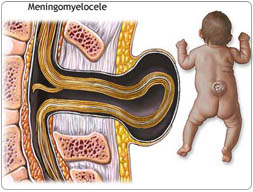Meningomyelocele: Protrusion of the membranes that cover the spine but some of the spinal cord itself through a defect in the bony encasement of the vertebral column. The bony defect is spina bifida. Spina Bifida is a developmental anomaly characterized by defective closure of the bony encasement of the spinal cord through which the spinal cord and meninges may or may not protrude.
If the anomaly is not visible, the condition is called spina bifida occulta.
If there is an external protrusion of the saclike structure, the condition is called spina bifida cystica, and is further classified according to extent of neural involvement (e.g., meningocele, meningomyelocele, or myelomeningocele).
Description of Spina Bifida
 Spina bifida is the most frequently occurring permanently disabling birth defect. It affects approximately one out of every 1,000 newborns in the U.S. More children are affected by this condition than muscular dystrophy, multiple sclerosis, and cystic fibrosis combined.
Spina bifida is the most frequently occurring permanently disabling birth defect. It affects approximately one out of every 1,000 newborns in the U.S. More children are affected by this condition than muscular dystrophy, multiple sclerosis, and cystic fibrosis combined.
Spina bifida is a disabling birth defect of the spinal column resulting from the failure of the spinal column to close properly during the first month of pregnancy. In severe cases, the spinal cord protrudes through the back. The condition may cause varying degrees of paralysis and loss of feeling in the lower limbs, and bowel and bladder complications.
A large percentage of children born with spina bifida have hydrocephalus, the accumulation of fluid in the brain. Hydrocephalus is controlled by a surgical procedure called shunting which relieves the fluid buildup in the brain by redirecting it to the abdominal area.
Spina bifida occulta is a usually harmless form of spina bifida in which there is a small defect or gap in a few of the small bones (vertebrae) that make up the spine. The spinal cord and nerves are usually normal, and most affected individuals have no problems caused by this minor abnormality.
Meningocele is the rarest form of spina bifida in which a cyst or lump consisting of membranes surrounding the spinal cord pokes through the open part of the spine. The spinal cord and the nerves are usually normal. The cyst, which can be as small as a nut or as large as a grapefruit, can be removed by surgery, allowing the baby to develop normally.
Meningomyelocele is the most severe form of spina bifida. In this form, the cyst holds nerve roots of the spinal cord and often the cord itself. Or there may be no cyst, but only a fully exposed section of the spinal cord and nerves. Spinal fluid may leak out, and the area often is covered with sores. Affected babies are at high risk of infection until the back is closed surgically. In spite of surgery, varying degrees of leg paralysis and bladder and bowel control problems remain.
Causes and Risk Factors of Spina Bifida
The most important risk factor for spina bifida is poor nutrition, especially a diet deficient in folic acid.
There appears to be factors other than nutrition in the development of spina bifida. Genetics also seems to play a role. People of Northern European and Hungarian ancestry have the highest rates of the disease, and the condition tends to run in families, though not consistently. In fact, 90 to 95 percent of children with spina bifida are born to women who have no other children or anyone in the family with the defect.
Treatment of Spina Bifida
Meningocele, which does not involve the spinal cord, can usually be repaired surgically to preserve normal spinal function.
When a baby is born with the severest form of spina bifida, it usually is operated on at once - within 48 hours after birth. Doctors surgically release the spinal cord, replace it in the spinal canal and cover it with muscle and skin. Even so, limb paralysis and bowel problems usually remain. Specialists in orthopedics and urology are asked to treat these problems.
As soon after the operation as possible, a physical therapist teaches the parents how to exercise their baby's legs and feet to prepare for walking with leg braces and crutches. Some children need a wheelchair.
If the child develops hydrocephalus, fluid can be drained from the brain through surgical placement of a shunt. The shunt runs under the skin into the chest or abdomen, and the fluid passes harmlessly through the child's body.
With treatment, children with spina bifida usually can become active individuals. Most are able to have children, although such a pregnancy is considered "high risk."
Prevention of Spina Bifida
The United States Public Health Service since 1992 has recommended that all women of childbearing age who are capable of becoming pregnant should consume 0.4 mg of folic acid per day for the purpose of reducing their risk of having a pregnancy affected with spina bifida or other neural tube defects. Folic acid is found in foods such as cereals, broccoli, spinach and con. It is also available as a vitamin supplement.
Over the last few years, it has become apparent that folic acid can reduce by about 50 percent the risk of having a newborn with spina bifida. Unfortunately, many women do not eat enough folic acid-containing foods (such as leafy vegetables and citrus fruits). For this reason, the U.S. Food and Drug Administration is planning to require that flour, breads, rolls, buns, corn meal and grits, farina, rice, macaroni, and noodle products should be fortified with folic acid. It is considering whether to allow labels of foods that are good sources of folate to state that such foods can help reduce the risk of neural tube defects, and the same claim could be made on dietary supplements, such as multivitamins.
However, women should realize that it is important that they consume the vitamin every day, whether they are planning a pregnancy or not. Folic acid appears to work around the time of conception, so if women wait to start folic acid until they know they are pregnant, it is too late for the vitamin to offer benefit.
Advanced Reproductive Technology
- In Vitro Fertilisation (IVF)
- Intracytoplasmic Sperm Injection (ICSI)
- Donor egg and embryo programs
- In Vitro Fertilisation (IVF)
- Pre-implantation genetic diagnosis (PGD)
- Surrogacy programs
Dental Videos





